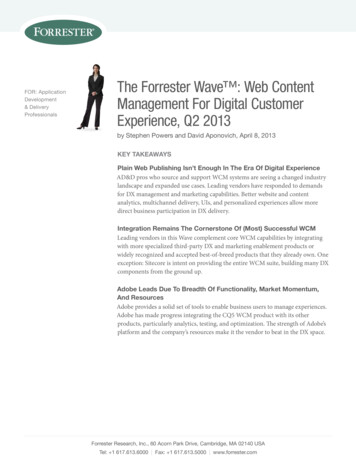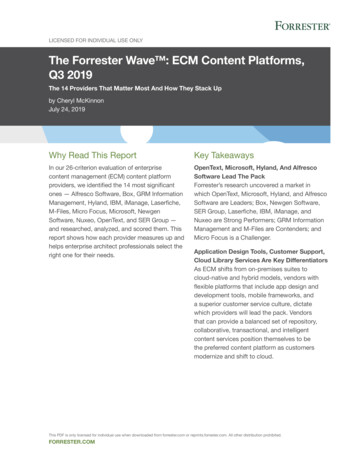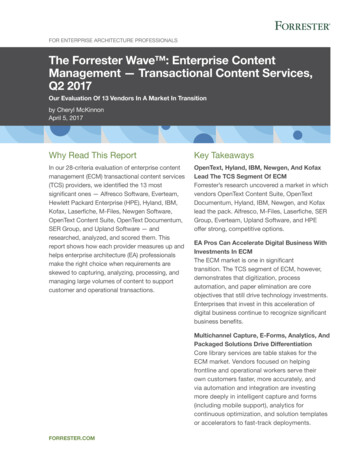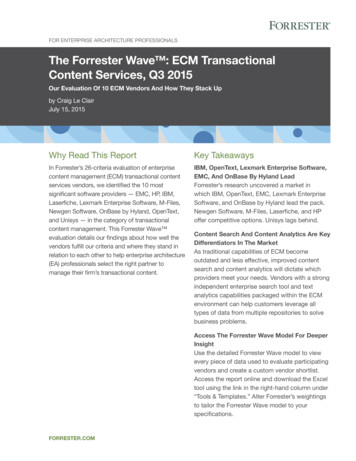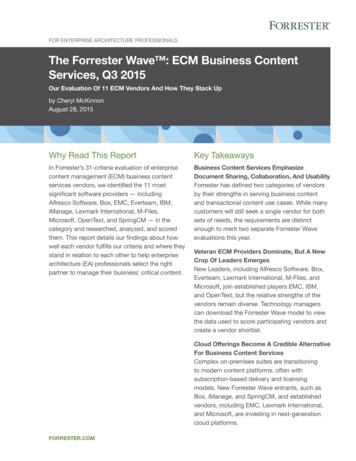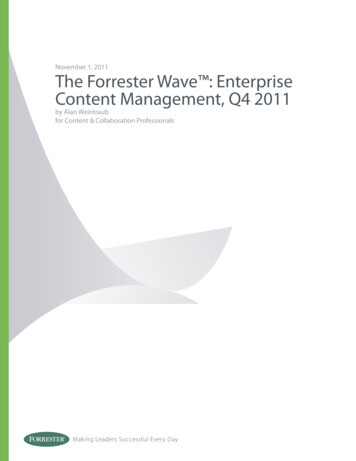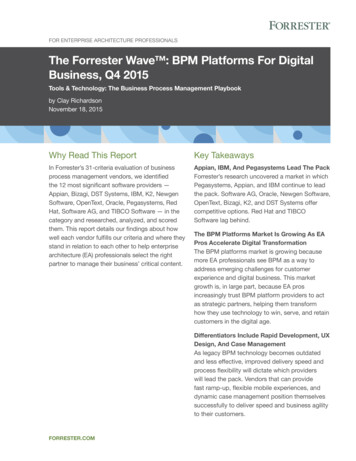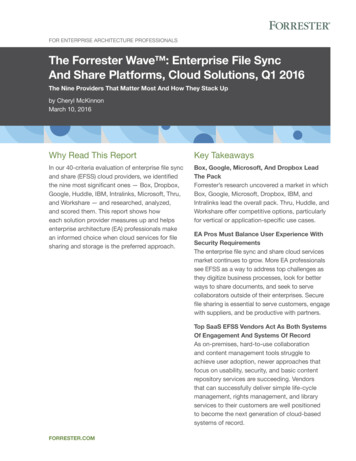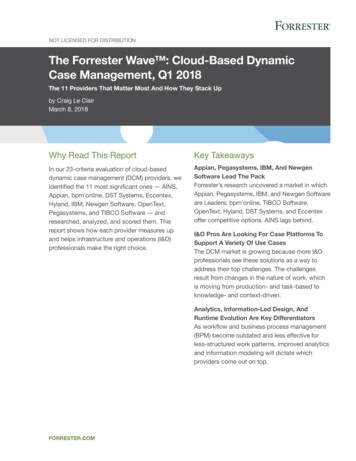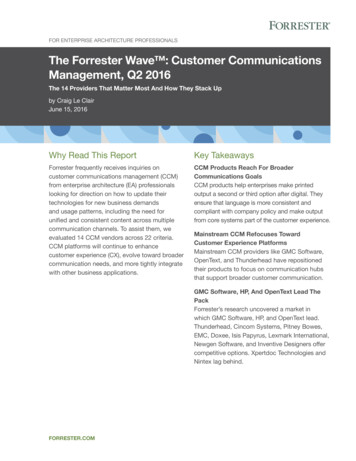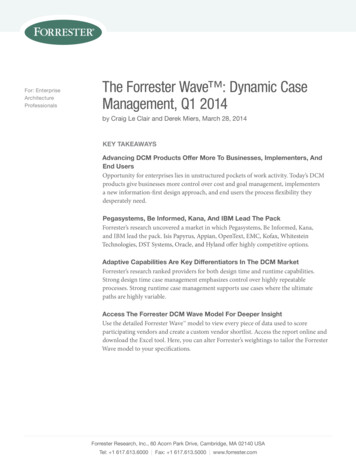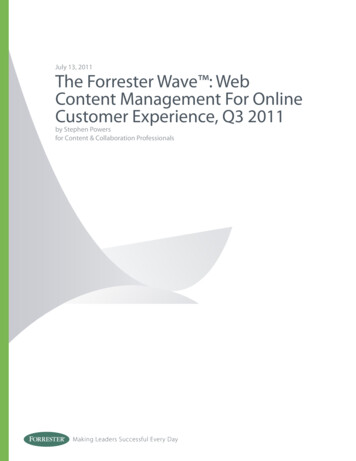
Transcription
July 13, 2011The Forrester Wave : WebContent Management For OnlineCustomer Experience, Q3 2011by Stephen Powersfor Content & Collaboration ProfessionalsMaking Leaders Successful Every Day
For Content & Collaboration ProfessionalsJuly 13, 2011The Forrester Wave : Web Content ManagementFor Online Customer Experience, Q3 2011SDL And Adobe Lead The Way To Customer Experience Management (CXM)by Stephen Powerswith Matthew Brown and Joseph DangExec ut i v e S u mma ryThe web content management (WCM) market is in transition. Functionality to enable publishing tothe Web — whether internally or externally — has become commoditized. Yet now, the WCM marketis growing based on customer experience management (CXM) needs, including multichannel delivery,content targeting, analytics, and integration with other CXM technologies. Forrester evaluated 10WCM products across approximately 115 criteria and found that they have a lower level of maturitywhen viewed against these capabilities. SDL and Adobe lead due to their rich functionality, strategy,and enterprise track record. Strong Performers Sitecore, FatWire, OpenText, and Autonomy all providestrong options. Contender Ektron has solid functionality, but needs to work on its enterprise-level trackrecord. Contender IBM lacks the broad set of capabilities others have in WCM, but has other CXMsoftware assets and a strategic integration road map. Contenders Microsoft and Oracle have less of aCXM focus, but are legitimate alternatives for less interactive experiences.tabl e of Co n te nts2 A Multitude Of Players Populates The WCMMarket3 Customer Experience Management: The RealWCM Differentiator6 Web Content Management For OnlineCustomer Experience Evaluation Overview9 The Results: SDL And Adobe Lead, But AllNeed Work To Fully Support CXM11 Vendor ProfilesN OT E S & R E S O URCE SForrester evaluated 10 products and 30 usercompanies.Related Research Documents“Web Content Management Is Alive And Well In2011 Thanks To Online Customer Experience”March 17, 2011“The Seven C’s Of Web Content Management”February 2, 201115 Supplemental Material 2011 Forrester Research, Inc. All rights reserved. Forrester, Forrester Wave, RoleView, Technographics, TechRankings, and Total EconomicImpact are trademarks of Forrester Research, Inc. All other trademarks are the property of their respective owners. Reproduction or sharing of thiscontent in any form without prior written permission is strictly prohibited. To purchase reprints of this document, please email clientsupport@forrester.com. For additional reproduction and usage information, see Forrester’s Citation Policy located at www.forrester.com. Information isbased on best available resources. Opinions reflect judgment at the time and are subject to change.
2The Forrester Wave : Web Content Management For Online Customer Experience, Q3 2011For Content & Collaboration Professionalsa multitude of players populates the wcm marketEvolving multichannel needs and the absence of any truly dominant players have led to afragmented WCM market. A large number of vendors now support internal and external webpublishing and experience management requirements. These players include:· ECM vendors. Players such as IBM, Microsoft, Oracle, and OpenText have broad offeringsacross the entire enterprise content management (ECM) spectrum.1 ECM clients may findthat they can leverage existing relationships with these vendors to score favorable license dealsfor WCM products. OpenText continues to devote resources to two WCM products: WebExperience Management (formerly Vignette), which we have evaluated in this report, and WebSite Management (formerly RedDot), which the vendor targets at organizations that need toquickly create and deploy both internal and external websites. In addition, since we performedthis evaluation, Oracle announced its intention to acquire FatWire, giving it a stronger entry inthe CXM space.· CXM stack players. An array of vendors have begun to put together some, though not all,of the technology pieces needed to support online CXM. IBM offers WCM, portal (IBMWebSphere), marketing tools (Unica), commerce (IBM WebSphere Commerce Server),and analytics (Coremetrics). Adobe has WCM (Day), analytics, testing and optimization,and recommendations (Omniture). SDL features WCM, globalization services, andrecommendations (Fredhopper). Autonomy has WCM, search engine technologies (IDOL), andtesting and optimization (Optimost). Alterian has WCM and marketing suite tools.· Independents. The field of independent WCM vendors is vast and includes midmarket players(Percussion and Clickability, a software-as-a-service player now owned by Limelight); thosewhich have previously targeted the midmarket and now aim to compete at the enterprise level(Sitecore, Ektron, and CrownPeak, another SaaS player); and a host of European players nowtargeting the North American market (Atex, CoreMedia, EPiServer, eSpirit, GX, and Kentico).· Open source. A host of open source players abound, although Forrester clients may find thebase level of functionality lower than some of the higher end, proprietary players in terms ofCXM capabilities. This field includes products that with commercial backing — such as thosefrom Alfresco, Drupal, DotNetNuke, eZ Systems, Jahia, Magnolia, and OpenCms — and thosethat are community-based, such as Drupal, Joomla, and Plone.July 13, 2011 2011, Forrester Research, Inc. Reproduction Prohibited
The Forrester Wave : Web Content Management For Online Customer Experience, Q3 2011For Content & Collaboration ProfessionalsCustomer experience management: the real WCM differentiatorA new type of online CXM solution set is emerging from the components of multiple technologies —including WCM — in order to better support the creation and management of rich, interactive,multichannel experiences. Forrester defines CXM as:A set of solutions which enable the management and delivery of dynamic, targeted, consistentcontent, offers, products, and service interactions across digitally enabled consumer touchpoints.2Previously, organizations, processes, and technologies to serve the online channels were siloed,resulting in overhead, inconsistent experiences, and inability to measure results. However, as onlineinitiatives have evolved and matured, so have product offerings to support those initiatives.The Key Components Of CXMThree categories of solutions comprise online CXM: those based on process, delivery, andmeasurement (see Figure 1).· Process-based solutions enable business users to create experiences. Process-based solutionsconsist of tools that business users (as opposed to IT users) use to create and manage structuredand unstructured content for customer experiences. This category includes WCM, digital assetmanagement (DAM), eCommerce, customer relationship management (CRM), marketingcampaign management, marketing resource management, desktop publishing tools (such asMicrosoft Word), and interactive development environments (IDEs).· Delivery solutions bring interactive experiences to customers. Vendors often tightly coupleboth WCM and eCommerce solutions with native delivery tiers, enabling businesses to createcontent and design and deliver experiences in a single package. But other technologies enableexperience delivery, including rules- or algorithm-based content targeting solutions like search,personalization, and recommendations engines; marketing automation solutions such ascampaign management and offer management; and customer service interaction managementsolutions that support customer data and history, customer self-service, knowledgemanagement, and customer feedback management.· Customer intelligence solutions enable businesses to gauge the success of experiences.A/B and multivariate testing enable marketers and business users to test out variations ofexperiences on certain demographics before rolling them out to a broader audience. Webanalytics tools give insight into how consumers consume content and interact with experiences.Social analytics provide insight into how consumers engage with companies by monitoringsocial interactions. 2011, Forrester Research, Inc. Reproduction ProhibitedJuly 13, 20113
4The Forrester Wave : Web Content Management For Online Customer Experience, Q3 2011For Content & Collaboration ProfessionalsFigure 1 A Variety Of Components Comprise CXM SolutionsWeb contentmanagementOn-site searchPersonalizationand marketingautomationAnalytics, test,and optimizationCommerceplatformsCustomer serviceinteractionmanagementSource: Forrester Research, Inc.58958WCM Becomes A Critical Cornerstone In A CXM FoundationCurrently, no single vendor or product offers all of the components of an online CXM ecosystem.Even if one did exist, most enterprises have made significant investments in existing CXMcomponents and can’t make the business case to rip and replace their tools. So integration betweenthese components will be an important component in the coming years (see Figure 2). WCM’sability to offer some of these CXM features, as well as integrate with others, is a key component ofsuccess (see Figure 3).July 13, 2011 2011, Forrester Research, Inc. Reproduction Prohibited
The Forrester Wave : Web Content Management For Online Customer Experience, Q3 2011For Content & Collaboration ProfessionalsFigure 2 Decision-Makers Plan To Integrate WCM With Other Applications“With which other enterprise applications to you plan to integrate WCM? Please rank the following.”Top priority2nd priorityWeb analytics software3rd priority29%Customer relationship management (CRM)26%Digital asset management (DAM)14%Social networking platforms (such as Jive)8%Email campaign software8%Testing and optimization tools(A/B and/or multivariate)8%Enterprise marketing suites 7%22%12%17%15%10%12%13%17%13%11%11%18%13%15%Base: 218 WCM decision-makers primarily supporting public-facing websitesSource: January 2011 Global Web Content Management Online Survey58958 2011, Forrester Research, Inc. Reproduction ProhibitedSource: Forrester Research, Inc.July 13, 20115
6The Forrester Wave : Web Content Management For Online Customer Experience, Q3 2011For Content & Collaboration ProfessionalsFigure 3 WCM Decision-Makers Plan Customer Experience Initiatives“Which of the following does your organization currently deploy, or plan to deploy in the next12 months, in support of enhancing the customer experience? Please select all that apply.”Currently deployPlan to deploy in next 12 months22%Delivery to mobile devices54%49%Video streaming or downloading40%Rich internet applications (AJAX, Flash, etc.)Content targeting based on site visitor browsing behavior25%15%User-generated content (reviews, comments, threadeddiscussions, user ratings or polls, otheruser-generated content)Analytics information integrated within the contextof the content management environment47%28%Distribution of content to social networking sites(e.g., Facebook)33%21%40%21%39%36%Email campaigns intended to drive website trafficContent targeting for authenticated site visitors24%23%18%39%Localization (e.g., websites with varying content and/orlanguage based on geographic region)30%23%eCommerce functionality29%23%End user customization (ability for sitevisitors to set preferences)19%Testing and optimization (A/B and multivariate testing) 12%Automatic classification of content14%33%36%28%Base: 218 WCM decision-makers primarily supporting public-facing websitesSource: January 2011 Global Web Content Management Online Survey58958Source: Forrester Research, Inc.Web content management for online customer experience EvaluationOverviewTo assess the state of the WCM market and see how the vendors stack up against each other,Forrester evaluated the strengths and weaknesses of top WCM vendors.July 13, 2011 2011, Forrester Research, Inc. Reproduction Prohibited
The Forrester Wave : Web Content Management For Online Customer Experience, Q3 2011For Content & Collaboration ProfessionalsEvaluation Criteria: Current Offering, Strategy, And Market PresenceAfter examining past research, user need assessments, and vendor and expert interviews, wedeveloped a comprehensive set of evaluation criteria. We evaluated vendors against 110 criteria,which we grouped into three high-level buckets:· Current offering. To assess product strength, we evaluated each offering against 10 groups ofcriteria: 1) content authoring; 2) presentation management; 3) library services; 4) globalizationand localization; 5) publishing and deployment; 6) content targeting; 7) multichannel delivery; 8)customer experience integration; 9) social and community tools; and 10) product architecture.· Strategy. We reviewed each vendor’s strategy, evaluating how well each vendor’s plannedenhancements will position it to support current and evolving CXM requirements, and whetheror not the vendor has a path to deliver those enhancements given its current technology,internal resources, and partnerships.· Market presence. To determine a vendor’s market presence, we evaluated each vendor’s installedbase, company financials, professional services, global presence, and license and reseller partners.Vendors Selected For CXM Functionality And Enterprise Track RecordIn this evaluation, Forrester examined vendors that enable marketing and business teams to useWCM in conjunction with other components of the CXM ecosystem to support rich, interactive,multichannel customer experiences. Forrester included 10 vendors in the assessment: Adobe,Autonomy, Ektron, FatWire, IBM, Microsoft, OpenText, Oracle, SDL, and Sitecore. The WCMmarket remains somewhat fragmented, but these 10 vendors represent the strongest in terms ofstability, functionality, and experience providing the primary WCM product for firms within theForrester client base. Specifically, each of these vendors has (see Figure 4):· A product supporting interactive, multichannel experience rather than just web publishing.Products in this category not only have content management and web publishing capabilities,but also have capabilities — such as content targeting, social tools, and enterprise applicationintegration — supporting interactive multichannel experiences.· Significant track record as the primary WCM for customer experience in largeorganizations. This category comprises vendor solutions primarily targeted towardorganizations with revenues of more than 1 billion per year. WCM vendors in this categoryfocus on enterprise-class organizations, scale to serve large user populations and support highlytrafficked websites, and offer multisite and multilingual support.· Interest from Forrester clients. Forrester clients repeatedly ask about the evaluated productswithin the context of inquiry, advisory, and consulting, and/or have them installed as theprimary WCM for supporting customer experience-based websites. 2011, Forrester Research, Inc. Reproduction ProhibitedJuly 13, 20117
8The Forrester Wave : Web Content Management For Online Customer Experience, Q3 2011For Content & Collaboration Professionals· A minimum of approximately 25 million in annual revenues. Vendors included in thisevaluation have a proven WCM product and generate approximately 25 million or more inannual revenue.Figure 4 Evaluated Vendors: Product Information And Selection CriteriaVersionRelease Date5.4February 2011VendorProduct NameAdobeCQ5AutonomyAutonomy TeamSiteAutonomy LiveSiteEktronCMS400.NET8.02October 2010FatWireFatWire Content Server7.5.5September 2010IBMIBM Web Content ManagementMicrosoftSharePoint ServerOpenTextWeb Experience ManagementOracle772010June 2010August 2010May 20108December 2009Universal Content ManagementWeb Content Management11gr2September 2009SDLSDL Tridion2011January 2011SitecoreSitecore Web Content ManagementSystem (CMS)Sitecore Online Marketing Suite6.4.1January 20111.1.1November 2010Inclusion criteriaA product supporting interactive, multichannel experience rather than just web publishing.Products in this category not only have content management and web publishing capabilities, but alsohave capabilities — such as content targeting, social tools, and enterprise application integration —supporting interactive multichannel experiences.Significant track record as the primary WCM for customer experience in large organizations. Thiscategory comprises vendor solutions primarily targeted toward organizations with revenues of more than 1 billion per year. WCM vendors in this category focus on enterprise-class organizations, scale to servelarge user populations and support highly trafficked websites, and offer multisite and multilingualsupport.Interest from Forrester clients. Forrester clients repeatedly ask about the included products within thecontext of inquiry, advisory, and consulting, and/or have them installed as the primary WCM forsupporting customer experience-based websites.A minimum of approximately 25 million in annual revenues. Vendors included in this evaluationhave a proven WCM product and generate approximately 25 million or more in annual revenue.Source: Forrester Research, Inc.July 13, 2011 2011, Forrester Research, Inc. Reproduction Prohibited
The Forrester Wave : Web Content Management For Online Customer Experience, Q3 2011For Content & Collaboration ProfessionalsThe results: SDL and adobe lead, but all need work to fully support cxmThe evaluation uncovered a market in which (see Figure 5):· SDL and Adobe lead due to breadth of functionality, market momentum, and track record.Both Adobe and SDL provides a solid set of tools aimed at enabling business users to manageexperiences. SDL’s globalization and localization functionality remains a differentiator and hasthe potential to be an asset for mobile website management. Adobe has an excellent offeringin terms of technology and features, and its integration with other Adobe-owned CXMcomponents shows potential.· Autonomy, OpenText, FatWire, and Sitecore offer competitive options. Autonomy, a Leaderin The Forrester Wave : Web Content Management For External Sites, Q2 2009, has multipleCXM components, although its demo did not reflect as broad a set of functionality as SDL andAdobe. OpenText’s Web Experience Management product has a new architecture and solidfunctionality, but needs more integration with complementary products. FatWire’s product stillhas strong functionality, although some of its peers have caught up to the vendor, which wasalso a Leader in the 2009 Forrester Wave report.3 Sitecore shows a great deal of momentumwith its strong feature set and product vision, but needs to continue to prove itself as the soleprovider of experience-based WCM with larger customers.· Ektron offers broad functionality but needs to prove itself at the enterprise level. Ektron hasa solid set of functionality, but to be truly relevant to Forrester clients it needs to work on itscustomer reference list to build a track record as the primary CXM-based WCM for large-scalesites that use advanced features such as content targeting and multichannel delivery.· IBM, Microsoft, and Oracle have narrower functionality but potential differentiators. Thesethree products don’t currently offer the same level of CXM-based functionality as their peersin this report, although Oracle has taken a step in that direction with its purchase of FatWire.Each of these vendors does offer potential in terms of resources (all have deep pockets) andcomplementary products (search and commerce for Microsoft; commerce, CRM, and predictiveanalytics for Oracle; and analytics, commerce, and testing/optimization for IBM).This evaluation of the WCM market is intended to be a starting point only. We encourage readersto view detailed product evaluations and adapt the criteria weightings to fit their individual needsthrough the Forrester Wave Excel-based vendor comparison tool. 2011, Forrester Research, Inc. Reproduction ProhibitedJuly 13, 20119
10The Forrester Wave : Web Content Management For O
The Forrester Wave : Web Content Management For Online Customer Experience, Q3 2011 . across the entire enterprise content management (ECM) spectrum.1 ECM clients may find that they can leverage existing relation
